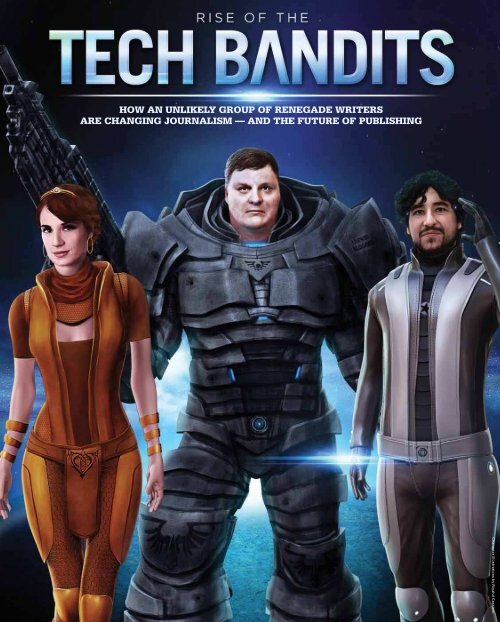GLOBAL SMARTPHONE REVENUE - Typepad
GLOBAL SMARTPHONE REVENUE - Typepad
GLOBAL SMARTPHONE REVENUE - Typepad
Create successful ePaper yourself
Turn your PDF publications into a flip-book with our unique Google optimized e-Paper software.
HOW AN UNLIKELY GROUP OF RENEGADE WRITERS<br />
ARE CHANGING JOURNALISM — AND THE FUTURE OF PUBLISHING<br />
Character illustrations by Riyahd Cassiem<br />
TECH<br />
PUBLISHING<br />
TIMELINE<br />
Time Magazine names<br />
the personal computer its<br />
“Machine of the Year.”<br />
JANUARY<br />
1983<br />
To truly appreciate today’s plugged-in,<br />
multimedia, real-time, technology media<br />
business, you need to see it in action.<br />
And there’s no better showcase than<br />
one of Apple’s big product-launch events — the tech<br />
equivalent of the Super Bowl, except there’s at least<br />
three of them every year.<br />
The day starts early (early for me, at least) at the<br />
Moscone Center in San Francisco. It’s the first morning<br />
of Apple’s sold-out 2011 Worldwide Developers<br />
Conference (WWDC), and Apple CEO Steve Jobs<br />
is about to deliver what will end up being his last<br />
“Stevenote.” (At 4:15 a.m., a line of people two blocks<br />
long was already waiting to get in.)<br />
After a quick check-in (press members get to skip<br />
the big line) and a trip up a couple of tall escalators,<br />
I reach the top floor, where a couple hundred<br />
journalists, handlers and special guests are shooting<br />
the breeze before the presentation.<br />
A line of photographers waits to get in. A cluster<br />
of writers mills about. But when the doors open, all<br />
order is lost. If you want a good seat in front, it’s time<br />
to run. This is about as close to a full-contact sport as<br />
tech journalism gets.<br />
I power walk and wind up close to the stage, off to<br />
the side. Good enough. This will be my mission control<br />
center for the next two hours, as I shuffle between<br />
trying to live-blog, while fighting the Moscone Center’s<br />
Wi-Fi and my iPhone’s helpless hotspot mode, and<br />
trying to take photos of what’s happening on stage.<br />
All around, there’s a strange hum of productivity:<br />
a symphony of dozens of MacBook keyboards tapping<br />
out live updates, cameras fluttering, oohs and ahhs,<br />
and punctuations of polite applause coming from the<br />
nonpress side of the auditorium. Jobs seems tired, and<br />
the announcements — new versions of Mac OS X, iOS<br />
and iCloud — are important but not as sexy as, say, a<br />
new iPhone.<br />
But what’s going on in this room is pretty<br />
amazing. Dozens — hundreds? — of sites are<br />
DECEMBER<br />
1983<br />
PC Magazine tops<br />
out at 773 pages.<br />
Apple’s iconic 1984 Super<br />
Bowl commercial airs.<br />
JANUARY<br />
1984<br />
1992<br />
cNET founded by<br />
Halsey Minor.<br />
publishing in real time, live from the scene. (At Jobs’<br />
WWDC keynote in 2010, the live-bloggers jammed the<br />
Wi-Fi so badly that Jobs had to pause his presentation<br />
and scold people to turn off their devices.)<br />
Announcements and photos get posted seconds<br />
after the fact, along with snippets of pithy analysis,<br />
and that’s just the first draft of coverage. Over the<br />
course of the day, AOL’s big gadget site Engadget will<br />
post no fewer than 16 articles about the day’s news.<br />
My colleagues and I at Business Insider end up posting<br />
34 headlines. And so on.<br />
That is today’s tech news industry in action.<br />
Frenetic, dramatic, sometimes flawed — but usually<br />
awesome. Tech industry executives and enthusiasts<br />
have never been better informed or entertained, live<br />
and in stereo. But it has taken 30 years to get here.<br />
The Boom Years<br />
“The year of the mouse! The Apple Lisa! The<br />
Macintosh!” Philip Elmer-DeWitt recalls some of<br />
the technology stories he wrote for Time Magazine,<br />
starting in the early 1980s. “The IBM PC! We did the<br />
Machine of the Year.” Later that year, PC Magazine<br />
would peak at 773 pages.<br />
The dotcom boom was still a decade away, but<br />
“Time was discovering computers gung-ho,” says<br />
Elmer-DeWitt, a long-time technology and science<br />
editor and writer at Time, who now writes a businessfocused<br />
blog about Apple for Fortune, another Time<br />
Inc. title.<br />
The challenge Time had in covering technology,<br />
Elmer-DeWitt says, was that “it was run by a bunch of<br />
old fuddy-duddies who didn’t use computers. And they<br />
didn’t really know what they wanted. At one point,<br />
Walter Isaacson [the former Time editor who recently<br />
wrote Steve Jobs’ biography] made me write a story<br />
about ‘cyberpunk.’ He had no idea what that meant,<br />
but he loved the word and he wanted it on the cover<br />
of Time, so I had to scratch together a story. I’m totally<br />
embarrassed by it.”<br />
Wired magazine, the<br />
“Rolling Stone of<br />
technology,” launches.<br />
JANUARY<br />
1993<br />
NOVEMBER<br />
1995<br />
Bill Gates publishes<br />
The Road Ahead.<br />
JASON CALACANIS<br />
Jason calacanis launches<br />
Silicon Alley Reporter, a<br />
magazine about the New<br />
York tech industry.<br />
1996<br />
17


